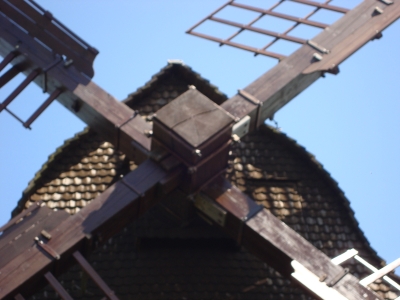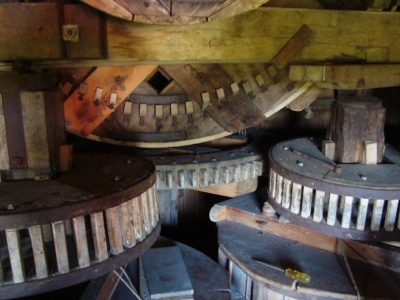The present Stouby Mill was build in 1750. It was presumably moved to its present location in 1790.
The Mill was probably expanded at this time in order that it could hold 2 grinding mills.
After 1820 agricultural production increased due to implementation of reforms in 1789. This resulted in the forming
of a new class of large farmers, which again resulted in increased yield of grain, and the demand for higher quality
of the grind of corn, and when horses superseded oxen as draught animals a need for sift as well as SKALKVÆRN arose.
A Post-Mill has the advantage of being easy to disassemble and move to a new location.
In 1790 the Industrialization had not yet reached Stouby, so the existence of Stouby Mill was as in the Middle Age based
on grinding of grain for farming and household for the surrounding country side. It was around the year 1250 that
the post mill was introduced in Denmark.
The poputaion in Denmark in 1790 was approximately 1 million inhabitants of which 80% or more were immediately
dependent on farming, and they lived in the country side.
The Mill-owner was husband and master, and like landowners, farmers and master artisans had autonomous power
over his household including the reight to take dispositions and to punish his household. The Miller had in fact status as
the major landowners, and could be compared to Master Artisans in the different guilds.
In the years around 1850 and after the implementation of the new constitution the prosperous farmers started to purchase
the freedom of their farms after they gradually had their own mills build.
The Mill in Stouby was hereafter mostly used by poor small-holders, who did not have money for their own grounding
mill. Like farming assistants and day-laborers lived a miserable life, while the prosperous farmers grew richer and richer.
In 1931 it was probably no longer worthwhile to keep the mill working, and it might have been superseded by a smaller
grinding mill with attached sieve pulled by an engine driven by petroleum exactly the same way as it was done in the farms, where
these engines or the newer electric motors were replacing the windmills in order not to be dependent on the weather conditions.
A Bakery was previously located, where the Glass-bowing facility is presently situated. The flour for the bakery was however most
likely delivered from the steam-mills before the bakery was closed.
In the 1950`s engineer Anders Jespersen registered all mills worthy of preservation for the National Museum. At this time
Stouby Mill was registered as unique, because it is the only one Post-Mill in Denmark, where 3 grounding mills runs a star wheel.
Sydfalster Municipal took over Stouby Mill in 1984, and in co-operation with a series of funds financial support was raised
for restoration of the mill. The restoration was mainly performed by local craftsmen under the supervision of Frede Dahl
from the NAtional Museum.
The restoration work was finalized in 1986, and the Mill was experimentally set to work. In 1987 Sydfalster Municipal handed
over the running and manitanance of the Mill to Stouby Møllelaug. (Mill-guild)
Today the Mill is owned by Guldborgsund Municipal, while Stouby Møllelaug is reponsible for the daily running,
maintenance and display of the Mill.



